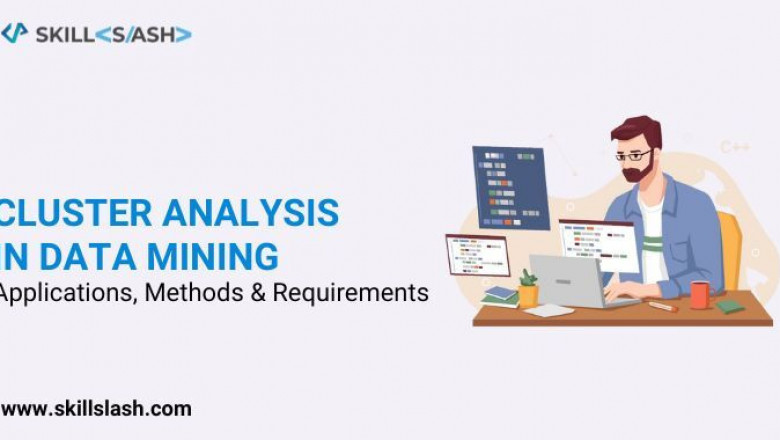views

In this article, we will discuss cluster analysis in data mining where we include its applications, requirements, and different methods. Without any ado, let's get started.
Cluster Analysis Applications in Data Mining
Data clustering analysis has a wide range of applications, including those in the fields of image processing, data analysis, pattern recognition, market research, and many more. To better understand their clientele, businesses might use data clustering to identify previously unrecognized subsets. Additionally, they can divide the current clientele into subsets delineated by their purchasing habits. Purchasing habits can also be used as a criterion for data classification.
The use of taxonomy, or the classification of creatures using a method like cluster analysis, is widespread in the study of biology. Species that share comparable genetic traits and capabilities can be more easily identified and grouped via clustering, and we can gain insight into some of the most widely observed inherent patterns of different populations by doing so as well. Clustering in data mining is used to determine regions. Similar regions of land are grouped in the Earth observation database.
Neighborhoods are identified in the city by their location, median home price, and predominant housing style. Information discovery in data mining is aided by clustering, which organizes data stored in online databases. Detection applications are another common usage for it. Clustering in data mining examines the pattern of deceit, making it simple to spot credit card fraud.
Cluster analysis is a useful tool for studying data clusters and learning more about their individual properties. This aids in comprehending the unique qualities of each cluster. One can gain insight into the data's distribution, and it serves as a useful tool in the process of data mining.
Clustering Analysis Requirements in Data Mining
● Interpretability
The outcome of cluster analysis ought to be something that can be put to good use, understood, and interpreted. Ensuring unstructured data is organized into groups with comparable characteristics is the primary goal of clustering in data analytics.
● Helpful for cleaning up messy data
The information is typically disordered and disorganized. Data mining relies heavily on clustering to make sense of large datasets that defy speedy analysis. By classifying records into sets with shared characteristics, grouping helps provide a framework for the information. The data expert's job, which includes processing the data and discovering new insights, is simplified. It is significantly simpler to analyze clustered data than unstructured data because the former has already been classed and labeled. This method also reduces the potential for mistakes.
● High Dimensional
In addition to dealing with little data, data clustering may also deal with data that is big in dimensions. All data dimensions must be supported by data mining clustering methods.
Data Mining Clustering Methods
Let’s take a look at different types of clustering in data mining!
● Partitioning Clustering Method
With this approach, we'll pretend that the database objects are partitioned into sets of sizes m and p. Every partition will stand in for one of the clusters if m<p. After sorting things into groups, there are K of them.
● Hierarchical Clustering Methods
This method of hierarchical clustering is one of the numerous methods of clustering used in data mining. It works by transforming a given set of data objects into a hierarchical structure. The reasons for categorization are determined during the process of creating a hierarchical breakdown. To make a hierarchical decomposition, there are two distinct methods: the divisive method and the aggregative method.
● Density-Based Clustering Method
Density is emphasized heavily in this Data Mining clustering technique. This clustering strategy relies on the concept of mass. When using this type of clustering, the group of nodes will expand indefinitely. Each data point needs to be inside the group's radius plus at least one.
● Grid-Based Clustering Method
In this Grid-Based Clustering Approach, the objects are used to create a grid. The object space is partitioned into a fixed number of cells to create a Grid Structure.
● Model-Based Clustering Methods
Each cluster in this approach is theorized to locate the data that works best with the model. This technique clusters the density function to pinpoint the cluster.
● Constraint-Based Clustering Method
To carry out the clustering, application- or user-specific limitations are added. The user's requirement is known as the limitation. With the confines imposed by this kind of categorization, communication becomes highly participatory.
Final Words
We reached the final parts of the article, having successfully described the different cluster analysis elements in data mining. If you feel that your interest lies in the tech domain and precisely data science. Skillslash can help you there. Besides being the best Data Science Course provider in Hyderabad Skillslash provides a comprehensive Full-Stack Developer Course In Bangalore with a placement guarantee. Skillslash also offers Data Structure and Algorithm With System Design Course. Get in touch with the support team to know more.













